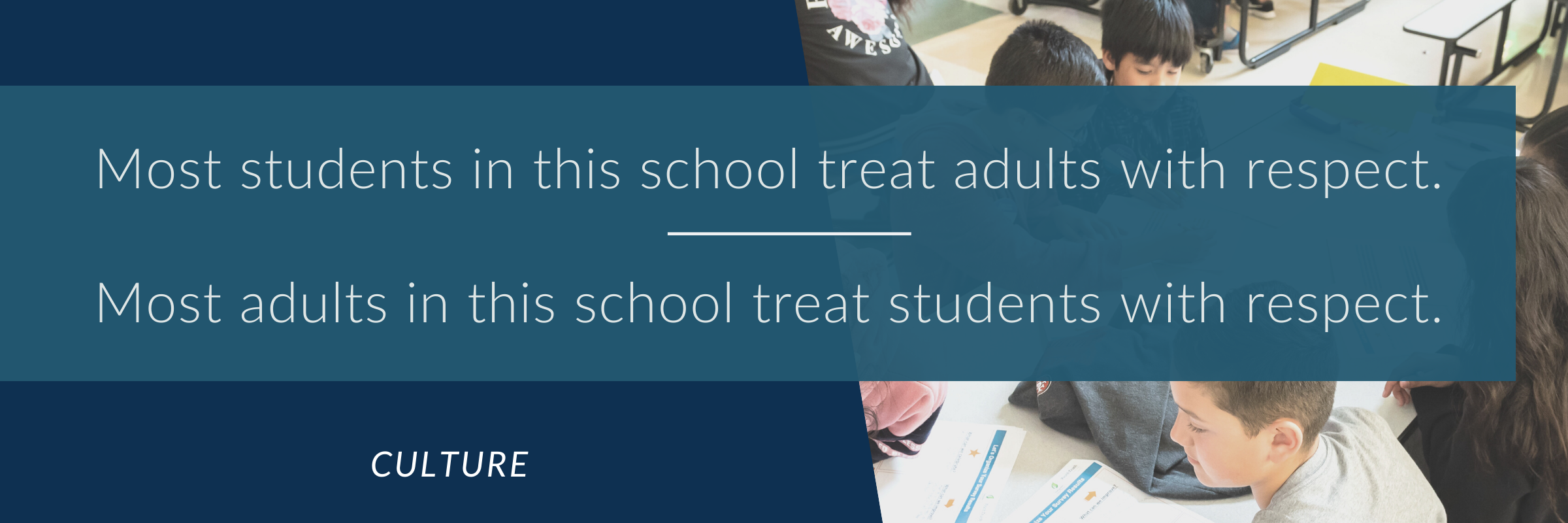
Why does it matter?
The YouthTruth survey asks two questions that measure mutual respect between students and adults in school. Teachers are most likely to receive respect from students if they exhibit respect toward students. That’s a human tendency — when disrespectful people demand respect, we don’t want to comply. If adults want respect from youth, they must start by modeling it.
Here, we’ll focus on a deeper definition of respect, going beyond courteous treatment. Here, respect also means being taken seriously, which in turn can lead to increased buy-in among both students and staff, as well as stronger relationships.
How to create a climate of respect
Respectful schools tend to be more democratic in that they create learning environments where people feel safe, supported, engaged, and challenged. In Volume 69 of ASCD’s Educational Leadership journal, Jonathan Cohen, Richard Cardillo, and Terry Pickeral list the essential elements that must be present in order to create this kind of productive environment:
- People are engaged and respected.
- Students, families, and educators work together to develop and contribute to a shared school vision.
- Educators model and nurture an attitude that emphasizes the benefits and satisfaction of learning.
- Each person contributes to the operation of the school and the care of the physical environment (National School Climate Council, 2007).
Cohen, Cardillo, and Pickeral also emphasize these four crucial goals:
Goal 1: Creating democratic communities
Students know when teachers honor their voices. Creating procedures to sincerely include students in shaping their learning environment is fundamental to engendering respectful and democratically informed classrooms (Marzano, Pickering, & Pollack, 2001). For example, you can use a backward design model to invite student perspective in establishing class guidelines. Ask students to brainstorm ideas on what their ideal classroom would look and sound like. Then invite youth to work together to create guidelines that will make everyone accountable for achieving this new vision.
Goal 2: Supporting students and teachers
Disrespectful behavior can often be a symptom of not feeling respected oneself. Use your YouthTruth survey results to figure out which groups of young people feel disrespected. Do you notice patterns based on gender, race/ethnicity, or self-reported grades? Students who are acting disrespectfully may need additional supports to make them feel safe in class. Consider: Do we uplift and empower this particular group of students? Do we celebrate their accomplishments? Do we truly hear their concerns?
Goal 3: Ensuring safe schools
When the brain doesn’t feel safe, learning can’t happen. Educators can increase social, emotional, and intellectual safety by acknowledging missed attempts and praising the mistakes that lead to improvement. For example when posing open-ended questions to the class, steer away from responses like, “Nope, incorrect! Next time, think before responding.” When students’ incorrect answers are met with disparagement, no one wants to risk being wrong. Instead, teachers can probe thinking with questions like, “How did you come to that conclusion? and How would you explain that answer to a younger child or to someone who did not understand?” Honoring all student responses without framing wrong answers as “bad” or “stupid” goes a long way in meeting students’ need for safety and acceptance.
Goal 4: Respect students’ time
When students feel that their learning is relevant and interesting, they’re engaged in their day-to-day work and stay focused on their long-term goals. Students expressing boredom are saying, “You’re not respecting my time.” The best way to respect students’ time is to provide juicy hooks for lessons, connect their learning to real-world applications, and give them assignments they can take pride in. Otherwise, bored students will find other ways to occupy their time in class, disrespecting their teachers in the process.
Strategies that work from Cohen, Cardillo, and Pickeral
1) Create opportunities for group decision making. Open dialogue engages students in a democratic process in which compromise rather than competition is crucial to making decisions.
2) Democratize the space. When group decision making or student interaction is key to an effort, rearrange the room. Change which way is the front, move all the desks to the side, or have students sit on the floor in a circle and link arms. Let students have a say; give them a chance to learn from their decisions.
3) Use multidimensional group projects, and vary the composition of the groups. A good group project should highlight different learning styles and skills. Graphic, textual, presentation, creative, and other components should have equal importance; successful completion of the project will require interdependency among group members.
4) Vary protocols for classroom sharing. Student sharing in classrooms typically comes through talking or writing; often the fastest or loudest wins the stage. Instead, use reflection and writing time to help students organize their thoughts, have students share through visual art without using language, or have students share in pairs or small groups. Focus on ways for the writer, the thinker, the talker, and the visual artist to share their ideas.
5) Create conflict around issues. When discussing issues in class, provide a more realistic experience of what a complex issue is. Taking different sides of an issue—not to compete and win, but to come to a collective decision—creates a democratic experience that demonstrates the messiness and complexity of the process.
The golden rule: measure and publicly recognize how we treat one another
Measuring how respectful a school is, and sharing what is learned, is a great way to reinvigorate effective, democratic classrooms, where all students feel they are being listened to and that their needs and opinions are respected.
